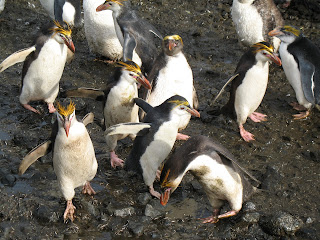Royal Penguin | The royal penguin is a medium to large sized species of penguin that is found inhabiting the freezing waters that surround the Antarctic continent. The royal penguin is best known for the yellow feathers than grow from it's forehead to the back of it's head and are not to be confused with the macaroni penguin which they are closely related to. Like other penguin species, the royal penguin spends the majority of it's life hunting out at sea and are usually found in the nutrient rich waters
that surround Antarctica. However, royal penguins are known to only
breed on Macquarie Island, a rocky south-western Pacific island that
lies roughly half way between New Zealand and Antarctica.
Until recently, the royal penguin and the macaroni penguin where thought to be the same species but there are a number of distinct differences between the two. Royal penguins have white chins and faces, where the face
of the macaroni penguin is black. Royal penguins also breed exclusively
on Macquarie Island, a place inhabited by no other penguin species. All
penguins are fantastic swimmers and the royal penguin is no exception. Royal penguins
use their powerful flippers and streamlined bodies, aided by their
webbed feet to soar through the water and are able to reach speeds of
nearly 20mph. Royal penguins also dive to depths of up to 150m in order
to catch food, with dives usually lasting for a few minutes.
The royal penguin is a carnivorous animal,
that like all other penguin species, survives on a diet that is only
comprised of marine animals. Krill and small crustaceans make up the
bulk of the royal penguin's diet along with larger organisms including
squid and various species of fish. Royal penguins can be at sea for days
at a time whilst hunting. The royal penguin has no natural land-based
predators due to the fact that royal penguins inhabit pretty
harsh environments. Large leopard seals hunt the royal penguin in the
water along with large sharks and killer whales. Royal penguin population have also been seriously affected by human hunting for the oil found in their feathers.
Royal penguins nest on beaches or on bare areas on slopes covered with vegetation along the island's coast. Royal penguins are colonial birds, nesting in scrapes on the ground up to a mile inland (these sites are known as rookeries). The female royal penguin lays two eggs which are incubated for 35 days. The chicks leave the nest after a couple of months returning when they are 5 to 6 years old to begin breeding themselves. Today, the royal penguin has been listed as a vulnerable species as populations were seriously affected by over hunting at the beginning of the 20th century. This species is now protected so can no longer be poached for it's oil.






No comments:
Post a Comment